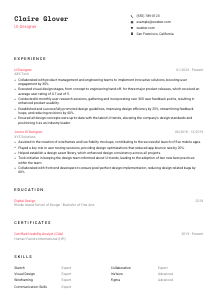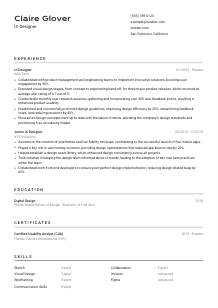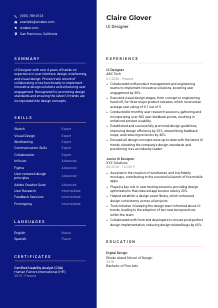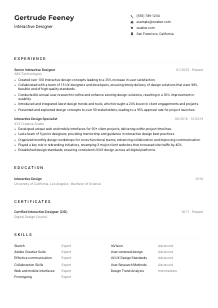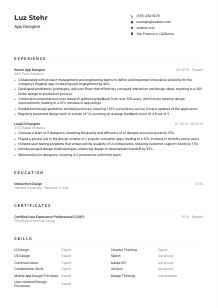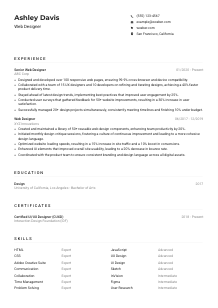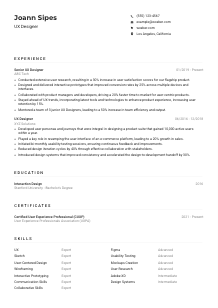UI Designer CV Example
Crafting user interfaces, but your CV feels off-grid? Navigate this UI Designer CV example, stylized with Wozber free CV builder. Grasp how to display your design sensibilities and user-centricity to match the career contours, making your professional journey as visually appealing as your interfaces!
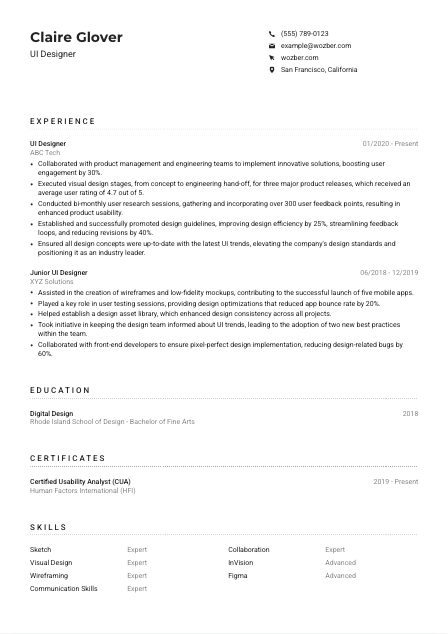
How to write an UI Designer CV?
Hey there, UI design aficionado! Ready to turn the design world upside down with your creativity and finesse? Great! But before you start beautifying the digital landscape, there's one crucial masterpiece you need to perfect – your CV.
Here, we'll guide you through tailoring your CV to a UI Designer position that screams 'hire me! ' With the help of the Wozber free CV builder, including its ATS-friendly CV templates and ATS CV scanner for keyword optimisation, you'll craft an ATS-compliant CV that aligns seamlessly with your dream job's requirements. Let's dive in and make your CV as compelling and user-friendly as your designs!
Personal Details
Imagine your CV's personal section as the loading screen to an app - it's essential to get it right to ensure the user (or in this case, the hiring manager) proceeds. Let's customize it for a UI Designer role, capturing all the necessary information without losing any style points.
1. Brand Thyself
Your name is the title of your personal brand. Imagine it at the top of your portfolio; it should be bold and clear. Use a font that's clean but unique – just like a good UI element.
2. Position Yourself
Right beneath your name, in the same eye-catching manner, list 'UI Designer.' It instantly communicates your expertise and synchronizes with the job you're aiming for.
3. Connect with Clarity
Ensure your contact info is as clear and straightforward as an intuitive interface. A professional email and a phone number are your clickable elements here. Double-check them; errors are not an option.
4. Location, Location, Location
The job's in San Francisco, and so are you? Highlight your locale right off the bat! It reassures the hiring manager that you're ready and available for the role without any complications.
5. Online Portfolio
In today's digital age, showing is equally, if not more, important as telling. Add a link to your online portfolio or LinkedIn profile. This section offers a 'click to explore more' option, providing deeper insights into your capabilities.
Takeaway
Think of the Personal Details section as the user-friendly landing page for your CV. It needs to be inviting, informative, and error-free. Nail this, and you set a positive tone for the rest of your CV journey.





Experience
In the world of UI design, your experience paints a picture of your capabilities and growth. Let's compile your experience section in a way that highlights your most relevant and impressive feats, resonating with the key responsibilities of the target job.
- Collaborated with product management and engineering teams to implement innovative solutions, boosting user engagement by 30%.
- Executed visual design stages, from concept to engineering hand‑off, for three major product releases, which received an average user rating of 4.7 out of 5.
- Conducted bi‑monthly user research sessions, gathering and incorporating over 300 user feedback points, resulting in enhanced product usability.
- Established and successfully promoted design guidelines, improving design efficiency by 25%, streamlining feedback loops, and reducing revisions by 40%.
- Ensured all design concepts were up‑to‑date with the latest UI trends, elevating the company's design standards and positioning it as an industry leader.
- Assisted in the creation of wireframes and low‑fidelity mockups, contributing to the successful launch of five mobile apps.
- Played a key role in user testing sessions, providing design optimisations that reduced app bounce rate by 20%.
- Helped establish a design asset library, which enhanced design consistency across all projects.
- Took initiative in keeping the design team informed about UI trends, leading to the adoption of two new best practices within the team.
- Collaborated with front‑end developers to ensure pixel‑perfect design implementation, reducing design‑related bugs by 60%.
1. Dissect the Job Description
Itemize the job requirements - 'Collaborated with product management', 'Executed visual design stages', etc. These phrases are your keywords; they unlock the next level – the interview.
2. Layout Your Progression
Arrange your roles chronologically, putting the spotlight on your journey. Each position should underline your growth – from 'Junior UI Designer' to 'UI Designer,' showcasing a storyline of developing expertise.
3. Detail Your Design Triumphs
For each role, draft accomplishment statements that echo the job ad. 'Boosted user engagement by 30%' speaks volumes, combining your success metrics with the tasks you'll be expected to perform.
4. Quantify Your Impact
Numbers are the universal language of impact. Whenever you can, quantify your achievements. A '60% reduction in design-related bugs' or a '30% increase in user engagement' offers tactile evidence of your value.
5. Relevance is Key
Every line should serve a purpose. Irrelevant experiences can clutter and dilute your narrative. Keep your content laser-focused on the UI Designer role, ensuring every point connects back to the job's requirements.
Takeaway
The Experience section is your portfolio within your CV. It showcases your evolution as a UI Designer. Make it a reflection of your dedication, creativity, and the tangible impact you've made. Remember, make every line count towards painting you as the ideal candidate.
Education
Your education provides the foundation for your career. While your design portfolio and experience take center stage, a well-crafted Education section corroborates your qualifications and specialization in the design world.
1. Identify the Degree Prerequisite
For our UI Designer role, a 'Bachelor's degree in Design, Computer Science, or related field' is your entry ticket. Make sure this is prominently displayed, aligning with the job's educational prerequisite.
2. The Art of Simplicity
Maintain a clean structure - your degree, field of study, institution, and graduation year. It's like designing a user-friendly interface; you want the information to be easily accessible and comprehensible.
3. Degree Specification
Be specific about your degree. 'Bachelor of Fine Arts in Digital Design' directly maps to the requirements of the job, demonstrating a perfect fit right off the bat.
4. Relevant Coursework
If you're fresh in the field, listing relevant coursework can give you an edge. Mention courses that have direct relevance to UI Design to show your targeted learning efforts.
5. Extras That Matter
Honors, clubs, or projects related to UI Design can add value, especially for recent graduates or those in early career stages. If it underscores your passion and aptitude for design, include it.
Takeaway
The Education section, when tailored and presented effectively, reinforces your qualifications for the UI Designer role. It's an essential chapter of your CV that supports the narrative of your developing career in design.
Certificates
In the fast-evolving field of UI design, certifications act as badges of honor, showcasing your continuous learning and mastery over current design principles and tools.
1. Audit the Job's Needs
Start by identifying if the job description lists specific certifications. Here, no explicit certifications were required, but including relevant ones like 'Certified Usability Analyst (CUA)' shows commitment to your craft.
2. Selection is Key
Choose certifications that resonate most with the UI Designer role. Quality trumps quantity – highlighting the most relevant certifications positions you as a serious contender who invests in their expertise.
3. Date Matters
Include acquisition dates, especially for recent certifications. This signals to the hiring manager that you're up-to-date with the latest trends and methodologies in UI design.
4. Keep Evolving
The tech and design landscapes are constantly changing. By pursuing and listing new certifications, you demonstrate your dedication to staying ahead of the curve, a critical trait for any UI Designer.
Takeaway
Certifications are your aces. When relevant and up-to-date, they strengthen your profile, affirming your expertise and specialization in UI design. Let these badges of honor shine brightly on your CV.
Skills
Your skills section is where you list your technical prowess and soft skills, shaping a snapshot of your capabilities as a UI Designer. A well-thought-out skills section can be a powerful component of your CV.
1. Decode the Job Listing
Highlight both the explicit and the implied skills necessary for the role. For instance, proficiency in 'Sketch, InVision, and Figma' is directly mentioned, marking them as must-haves on your CV.
2. Match and Map
Equally important are your soft skills. 'Strong communication' and a 'user-first mentality' from the job description should find a place in your skills section as they're essential to thriving in a collaborative design environment.
3. Organize and Prioritize
Keep your skills list neat and to the point. Prioritize those mentioned in the job listing, but also include others that make you a well-rounded candidate. Think of it as curating content for a clean, user-friendly interface.
Takeaway
Think of your skills section as the feature list of a highly-rated app. It should be compelling, concise, and tell the hiring manager at a glance why you're the best download option for this role. Anticipate the 'user's' needs and cater your 'features' accordingly.
Languages
The ability to communicate effectively in multiple languages can give you a significant edge, especially in companies with a global reach or diverse teams. It's like being equipped with different UI themes tailored for specific user groups.
1. List Job-Specific Languages
"Must be linguistically adept in English" was a key requirement. Make sure to list English first and indicate your proficiency as 'Native' or 'Fluent', adhering to the job's specifications.
2. Showcase Additional Languages
Even if not requested, showcasing fluency in additional languages can highlight your versatility. It's akin to supporting multiple user settings in an application, making you valuable to a broader user base.
3. Accuracy in Proficiency
Be honest about your language levels. Use descriptors like 'Native', 'Fluent', 'Intermediate', or 'Basic'. Incorrectly stating your proficiency can lead to miscommunications, just as a poorly designed UI can lead to user frustration.
4. Understand the Role's Requirements
While not always explicitly required, language skills are a plus. For a UI Designer, being able to understand and incorporate cross-cultural design sensitivities can enhance your appeal to internationally focused companies.
5. Keep Up to Date
Just as design trends evolve, so does language usage. Stay current in your language skills, and don't shy away from opportunities to practice and improve. It's all part of developing a well-rounded professional persona.
Takeaway
In today's globally connected world, language skills can open doors and break down barriers, much like a well-designed interface. Showcase your linguistic abilities proudly as they underline your capability to connect and communicate in a diverse workspace.
Summary
The summary is your chance to hook the hiring manager with a crisp, compelling narrative of who you are as a UI Designer. Think of it as the overview screen of your professional app – it needs to grab attention and entice further exploration.
1. Capture the Job's Essence
Begin by understanding the core of the UI Designer role – from 'designing innovative solutions' to 'ensuring high-quality user experiences.' These phrases are your guiding stars and should be mirrored in your summary.
2. Lead with Your Identity
State your professional identity confidently. 'UI Designer with over 4 years of hands-on experience' sets the stage by highlighting your expertise and time in the field.
3. Showcase Your Achievements
Mention your most relevant skills and achievements next. Whether it's 'boosting user engagement by 30%' or 'implementing innovative design solutions,' these highlights should resonate with the job you're applying for.
4. Concision is Key
Keep your summary engaging and to the point. It's the hook that encourages the hiring manager to dive deeper into your CV. Aim for 3-5 impactful lines that leave them wanting more.
Takeaway
Think of the summary section as your personal brand statement. It's your pitch, succinct yet powerful, hinting at the depth of your capabilities and the distinctive value you bring to the table. Craft it well, and set the tone for the rest of your CV.
Launching Your UI Designer Journey
You've just walked through a detailed roadmap to crafting a CV that not only meets but exceeds the expectations for a UI Designer role. Remember, your CV is more than a document – it's the key to unlocking your next career opportunity. Use this guide as your design framework, tailor every section with purpose, and ensure your CV passes through ATS with ease by leveraging Wozber's free CV builder. The ATS-friendly CV format and templates, combined with the ATS CV scanner for keyword optimisation, are what you need to ensure your CV is as polished and professional as your designs.
Now go forth, armed with these insights, and create a CV that lands you the job of your dreams. Your design future awaits!

- Bachelor's degree in Design, Computer Science, or a related field.
- Minimum of 3 years of experience in user interface design or a related field.
- Proficiency in visual design and wireframing tools such as Sketch, InVision, and Figma.
- Solid understanding of user-centered design principles and a user-first mentality.
- Strong communication skills with the ability to work collaboratively in a cross-functional team.
- Must be linguistically adept in English.
- Must be located in San Francisco, California.
- Collaborate with product management and engineering teams to define and implement innovative solutions for the product direction, visuals, and experience.
- Execute all visual design stages from concept to final hand-off to engineering.
- Conduct user research, testing, and feedback sessions to ensure high-quality user experiences.
- Establish and promote design guidelines, best practices, and standards.
- Stay up-to-date with the latest UI trends, techniques, and technologies to ensure designs are relevant and competitive.





